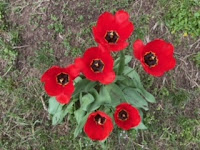I took this photo a couple of days ago, when—much to my surprise—this group of flowers appeared in my backyard.
I do not possess my late father’s green thumb, so
these shot up from the earth with no tending by me. I think of these as an
example of stubborn hope—the instinct in nature and people for rebirth,
even without our best efforts—even when so much conspires against it.
There is a second kind of hope, false hope—the illusory
belief that matters will advance far beyond the need for us to supervise or
take precautions. In other words, it’s the difference between pleasant surprise
that a few flowers will spring up after abundant rainfall and an expectation
that an entire garden can grow without the need to plant seeds or to ward off
creatures that will nibble at or rampage through the resulting product.
This past weekend, I saw more people than I’ve
glimpsed in more than a year in restaurants. These throngs, of course, are the
result partly of climbing temperatures, partly of pent-up demand after a year
of isolation, and partly of relaxed rules for gathering together.
In the coming months, we’re going to see if these
crowds and others sure to follow have come out due to stubborn hope or false
hope. I’d feel much better if our lives take a turn for the better through a
third type of hope, realistic hope: that matters can and will improve as
long as we remember that a good outcome is a product of human care rather than
human wishfulness.

No comments:
Post a Comment